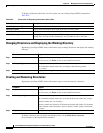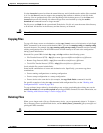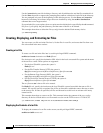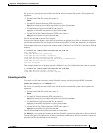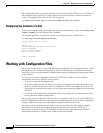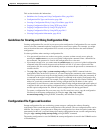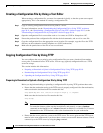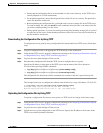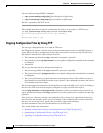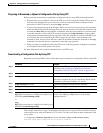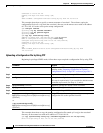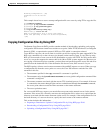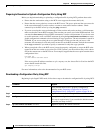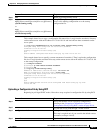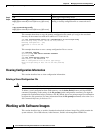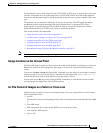
20-12
Cisco IOS Software Configuration Guide for Cisco Aironet Access Points
OL-11350-01
Chapter 20 Managing Firmware and Configurations
Working with Configuration Files
Use one of these privileged EXEC commands:
• copy system:running-config tftp:[[[//location]/directory]/filename]
• copy nvram:startup-config tftp:[[[//location]/directory]/filename]
The file is uploaded to the TFTP server.
This example shows how to upload a configuration file from an access point to a TFTP server:
ap# copy system:running-config tftp://172.16.2.155/tokyo-confg
Write file tokyo-confg on host 172.16.2.155? [confirm] y
#
Writing tokyo-confg!!! [OK]
Copying Configuration Files by Using FTP
You can copy configuration files to or from an FTP server.
The FTP protocol requires a client to send a remote username and password on each FTP request to a
server. When you copy a configuration file from the access point to a server by using FTP, the Cisco
IOS software sends the first valid username in this list:
• The username specified in the copy command if a username is specified.
• The username set by the ip ftp username username global configuration command if the command
is configured.
• Anonymous.
The access point sends the first valid password in this list:
• The password specified in the copy command if a password is specified.
• The password set by the ip ftp password password global configuration command if the command
is configured.
• The access point forms a password named username@apname.domain. The variable username is
the username associated with the current session, apname is the configured host name, and domain
is the domain of the access point.
The username and password must be associated with an account on the FTP server. If you are writing to
the server, the FTP server must be properly configured to accept your FTP write request.
Use the ip ftp username and ip ftp password commands to specify a username and password for all
copies. Include the username in the copy command if you want to specify only a username for that copy
operation.
If the server has a directory structure, the configuration file is written to or copied from the directory
associated with the username on the server. For example, if the configuration file resides in the home
directory of a user on the server, specify that user's name as the remote username.
For more information, refer to the documentation for your FTP server.
This section includes this information:
• Preparing to Download or Upload a Configuration File by Using FTP, page 20-13
• Downloading a Configuration File by Using FTP, page 20-13
• Uploading a Configuration File by Using FTP, page 20-14



